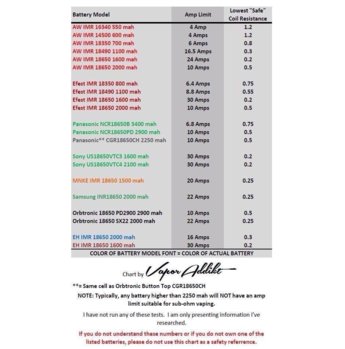Ok, so now that I have embarked on the Mech mod journey, I am getting myself up to speed with safe vaping practice for mech mods.
I know there have been discussions about battery chemistry, using a kick vs not using a kick, and some other useful bits and pieces, but I feel it was necessary to have one central thread tying it all together. If you are lazy, or don't want to get your head properly around the danger of sub-ohm vaping, or what can go wrong when you push the limits with a mech and/or have an accident, please at the very least watch the video at the bottom!
(Maybe the mods will make this into a sticky?)
Firstly, I think we need a Vape Safety Mascot. I have nominated the friendly Fukuppy for this role. If you don't know Fukuppy's story, go and google it. Its actually quite funny:

In the words of @Matthee
" Ignorance can be solved by education.....
BUT......there ain't no cure....for STUPID!!
And.....instructions are only helpful to those who READ 'EM....and HEED 'EM!!
NEVER hurts to "hammer home" safety, though!!
Happy (vaping)!"
So to kick off with, here is a general article about mechanical mod usage:
http://bumblevape.com/article/25/105/0/Mechanical Mod Proper Usage Guide
Want to see what can go wrong when your batteries catch fire?
http://www.e-cigarette-forum.com/fo...-battery-failure-imr-18650-a.html#post3265928
A quick explanation of different battery chemistry, and the risks of using one type versus another
http://www.e-cigarette-forum.com/fo...stion-about-batteries-vape-safe-mech-mod.html
For those who want (arguably) the most exhaustive resource detailing mechanical mod safety:
http://www.e-cigarette-forum.com/fo...-tips-vapors-looking-try-their-first-rba.html
@Matthee 's thread on RBA safety for beginners
http://www.ecigssa.co.za/threads/a-few-words-of-caution-about-rbas.661/
Should you use a kick (safety device) in your mech mod?
http://www.ecigssa.co.za/threads/to-kick-or-not-to-kick.727/#post-10971
The Mechanical Mod Safety video:
I would urge anyone exploring this exciting aspect of vaping culture to familiarize themselves with the science, methodology and mechanics of what they are doing when using mechanical mods. These things can be dangerous when abused or misused, and the last thing we want is for someone to get hurt or for something to happen which creates a bad image for the vaping community.
Disclaimer: The information is provided here as a general resource for those looking for information about safety when using mechanical mods. I cannot and will not be held responsible for any damage, harm, injury or loss that occurs to you, your property, those around you, or your equipment as a result of your own actions (be they willful or negligent). If you buy a mech mod you are obliged to understand and operate it in a manner that is safe to yourself, your property, your environment and those around you. Never underestimate the potential damage that can occur with high amp discharges, short circuits, poor workmanship and a lack of knowledge about what you are doing. Vape safe folks, and avoid any potential Fukuppys!
Mods: Please include any additional information that has not been included
I know there have been discussions about battery chemistry, using a kick vs not using a kick, and some other useful bits and pieces, but I feel it was necessary to have one central thread tying it all together. If you are lazy, or don't want to get your head properly around the danger of sub-ohm vaping, or what can go wrong when you push the limits with a mech and/or have an accident, please at the very least watch the video at the bottom!
(Maybe the mods will make this into a sticky?)
Firstly, I think we need a Vape Safety Mascot. I have nominated the friendly Fukuppy for this role. If you don't know Fukuppy's story, go and google it. Its actually quite funny:

In the words of @Matthee
" Ignorance can be solved by education.....
BUT......there ain't no cure....for STUPID!!
And.....instructions are only helpful to those who READ 'EM....and HEED 'EM!!
NEVER hurts to "hammer home" safety, though!!
Happy (vaping)!"
So to kick off with, here is a general article about mechanical mod usage:
http://bumblevape.com/article/25/105/0/Mechanical Mod Proper Usage Guide
Want to see what can go wrong when your batteries catch fire?
http://www.e-cigarette-forum.com/fo...-battery-failure-imr-18650-a.html#post3265928
A quick explanation of different battery chemistry, and the risks of using one type versus another
http://www.e-cigarette-forum.com/fo...stion-about-batteries-vape-safe-mech-mod.html
For those who want (arguably) the most exhaustive resource detailing mechanical mod safety:
http://www.e-cigarette-forum.com/fo...-tips-vapors-looking-try-their-first-rba.html
@Matthee 's thread on RBA safety for beginners
http://www.ecigssa.co.za/threads/a-few-words-of-caution-about-rbas.661/
Should you use a kick (safety device) in your mech mod?
http://www.ecigssa.co.za/threads/to-kick-or-not-to-kick.727/#post-10971
The Mechanical Mod Safety video:
I would urge anyone exploring this exciting aspect of vaping culture to familiarize themselves with the science, methodology and mechanics of what they are doing when using mechanical mods. These things can be dangerous when abused or misused, and the last thing we want is for someone to get hurt or for something to happen which creates a bad image for the vaping community.
Disclaimer: The information is provided here as a general resource for those looking for information about safety when using mechanical mods. I cannot and will not be held responsible for any damage, harm, injury or loss that occurs to you, your property, those around you, or your equipment as a result of your own actions (be they willful or negligent). If you buy a mech mod you are obliged to understand and operate it in a manner that is safe to yourself, your property, your environment and those around you. Never underestimate the potential damage that can occur with high amp discharges, short circuits, poor workmanship and a lack of knowledge about what you are doing. Vape safe folks, and avoid any potential Fukuppys!
Mods: Please include any additional information that has not been included








